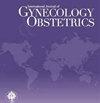De novo urethral hypermobility at 6 months after first delivery as a risk factor for stress urinary incontinence 12 years postpartum
Abstract
Objective
The aim of the study was to analyze the association between de novo urethral hypermobility 6 months postpartum and stress urinary incontinence (SUI) symptoms at 6 months and 12 years after first delivery. Risk factors associated with the development of postnatal urethral hypermobility were also examined.
Methods
A longitudinal cohort study was conducted on primigravid women, after excluding those with UI before pregnancy and/or urethral hypermobility (rotational angle ≥30°) at term. At 6 months postpartum, SUI was assessed based on symptoms and introital ultrasound performed to measure rotational angle (difference between urethro-pelvic angle at rest and at maximum Valsalva). Twelve years after delivery, women were sent a questionnaire including SUI assessment and questions on parity, current age, and body mass index. Continuous variables were compared using student's t-test and qualitative variables using chi-squared tests. A logistic regression model was constructed including variables that reached statistical significance (P < 0.05) in the univariate analysis.
Results
Of the 314 women who completed the 6-month follow-up, 265 (84.4%) were successfully contacted and completed the questionnaire at 12 years and these formed the study group. In 127 women (47.9%), de novo urethral hypermobility had developed by 6 months postpartum. There was no association between urethral hypermobility and SUI symptoms 6 months postpartum (OR: 1.17; 95% CI: 0.59–2.33). Twelve years after delivery, however, SUI was reported by 110 women overall (41.5%) and nearly half of the women who developed postnatal urethral hypermobility (61/127, 48.0%).
Conclusion
De novo urethral hypermobility 6 months postpartum constitutes a risk factor for SUI 12 years later.

 求助内容:
求助内容: 应助结果提醒方式:
应助结果提醒方式:


